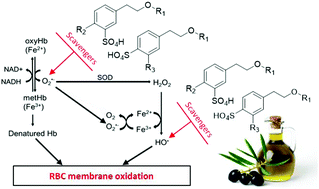The consumption of extra virgin olive oil (EVOO) has been associated with a lower incidence of cardiovascular diseases partly due to its polyphenol content. The metabolites hydroxytyrosol sulfate and hydroxytyrosol acetate sulfate were shown to be the most concentrated polyphenol metabolites found in plasma after EVOO consumption. Therefore, the capacity of hydroxytyrosol, hydroxytyrosol acetate, homovanillyl alcohol, homovanillyl alcohol acetate and tyrosol sulfate metabolites, to protect red blood cells (RBCs) from oxidative injury induced by the radical initiator 2,2′-azo-bis(2-amidinopropane) dihydrochloride (AAPH) was evaluated. In the presence of AAPH, all non-sulfated compounds and the hydroxytyrosol and hydroxytyrosol acetate monosulfate metabolites showed a significant protective activity against RBCs induced oxidative hemolysis. Moreover, even at 5 μM, the protection was highly significant for hydroxytyrosol acetate, hydroxytyrosol and hydroxytyrosol acetate 3′ and 4′ monosulfates. The morphological changes of RBC and the nature of their hemoglobin were in accordance with the hemolysis assay. Results showed that a free phenolic hydroxyl group is needed for the antioxidant protection given by compounds. Hydroxytyrosol metabolites present as phase II sulfate conjugates are actually able to protect RBC from oxidative injury by a non-transcriptional mechanism and are likely to contribute for the anti-atherosclerosis properties of regular EVOO consumption.

